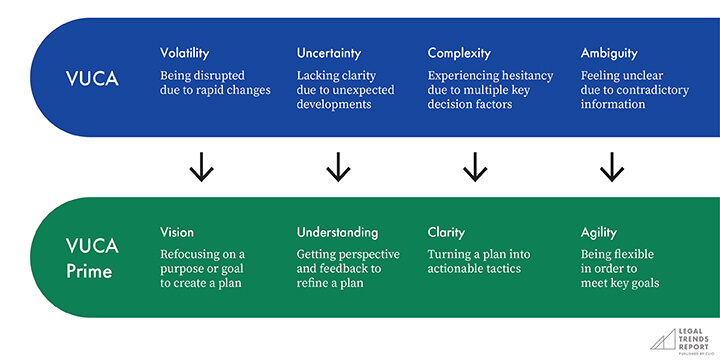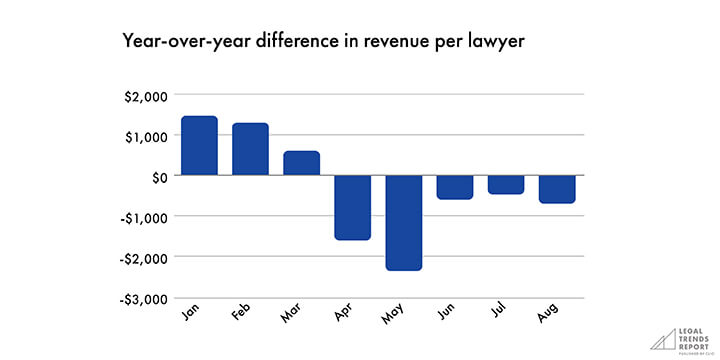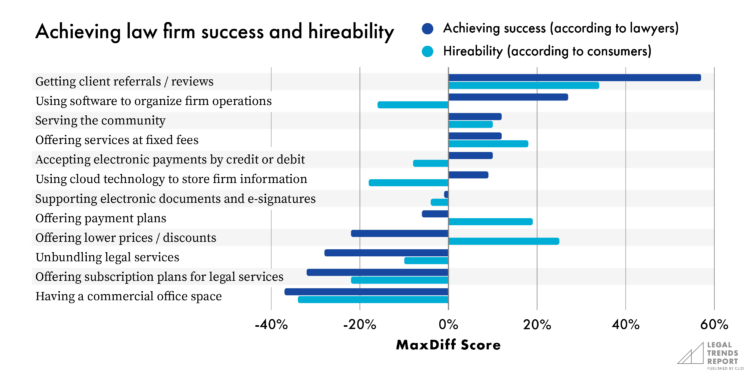Since 2016, legal professionals have relied on Clio’s annual Legal Trends Report for unbiased information and comprehensive, in-depth analyses of legal industry trends. As “one of the legal industry’s most important benchmarking tools,” as stated by Above the Law’s Joe Patrice, the 2020 Legal Trends Report is proving to be more useful than ever—especially in a year filled with sobering economic, political, and human rights challenges.
In this blog post, we’ll cover key points from the 2020 Legal Trends Report. We’ll also highlight the opportunity that the legal industry is facing despite 2020’s crises—the opportunity to rise to the challenges and build a better normal.
Building a better normal from a period of crisis
Needless to say, 2020’s events have created countless problems for legal professionals—specifically, the outbreak of the global pandemic. Although some challenges driven by the pandemic are new, many are simply magnified by our new normal. In fact, many issues stem from long-standing problems in the legal industry—like the access to justice gap, lagging technology adoption, lack of virtual systems, and mismatches between client expectations and client service.
However, these issues bring to light new opportunities for a better future. For example, the seismic shift from lawyers working in physical offices to working remotely will likely remain unchanged even after the pandemic. This lays the foundation for a new legal-service model that suits clients’ needs better. We will explore this further in the sections below, starting with the importance of creating a VUCA Prime environment.
The importance of creating a VUCA Prime environment

How should law firms find a way to thrive against the enormous uncertainty of 2020 and beyond? By creating a VUCA Prime environment to take advantage of the uncertainty. VUCA—which stands for volatility, uncertainty, complexity, and ambiguity—was originally a military term used to describe the difficult nature of modern battle situations. Its use has since evolved to refer to the chaotic and rapidly changing environment that businesses and organizations often find themselves in. VUCA Prime, on the other hand, is a model to help businesses and law firms thrive in a VUCA environment. It encourages law firms to face an uncertain world by turning volatility to vision, uncertainty to understanding, complexity to clarity, and ambiguity to agility.
Why is creating a VUCA Prime environment key to thriving in 2020 and beyond? Despite its turbulence, a VUCA environment creates huge opportunities for innovation. Law firms need to recognize the amount of change happening in legal services—including massive shifts in client expectations—and adapt to meet those changes. This way, law firms will be able to find lasting success.
You may like these posts
Focus on creating a positive-growth trajectory for your law firm
In periods of crisis, building a positive-growth trajectory for your law firm is more difficult than ever. However, by understanding and applying concepts like the aggregation of marginal gains, prioritizing clients, achieving product-market fit (more on these below), law firms can create a future for themselves that is cloud-based and client-centered, two critical pillars for surviving—and ultimately, thriving—in 2020 and beyond.
Work on aggregating and celebrating marginal gains

Developed by Dave Brailsford, the British Cycling coach, the aggregation of marginal gains is a concept that highlights the power of many small improvements. When these small improvements are added together, they result in dramatic improvements toward your goal. This concept makes sense—especially when you connect it to the 17th-century philosopher René Descartes who proclaimed: “Divide each difficulty into as many parts as is feasible and necessary to resolve it.”
Colossal problems like a shortfall in monthly revenue can cause tremendous stress and further financial strain for law firms. Data from the Legal Trends Report indicates that firms have seen monthly shortfalls of over $2,000 since the start of the coronavirus pandemic. Although it is difficult to find immediate solutions to recover these financial losses, law firms should focus on making small improvements to their business now. These improvements will ultimately help them survive these financial losses and ultimately, start growing again.
Law firms can apply the powerful “aggregation of marginal gains” framework to their business to not only see positive results, but also open up many paths to success. Read on to learn how law firms can make small changes in their businesses to help them survive 2020 and beyond.
Prioritize clients to survive and ultimately succeed

To help law firms gain clarity and perspective on what to focus on in their decision-making, we conducted a method of study known as a MaxDiff analysis to find out the most important priorities of lawyers and their clients. From reviewing data from over 2,000 respondents that include legal professionals and consumers, we found that when it comes to firm success, everything stems from the success of clients.
When looking at the other key factors in the MaxDiff analysis, we found three critical areas of opportunity for law firms to innovate in the coming months:
- Invest in law firm technology. Not only does technology adoption influence law firms’ resilience in times of crises, it also helps them gain more success in more profitable times.
- Redefine the affordability of legal services. Affordability does not simply mean lower prices. Instead, the 2020 Legal Trends Report found that consumers rank pricing and discounts, payment plans, and fixed fee billing as some of the most important criteria when it comes to hiring a lawyer. We’ll go into more detail about exactly how you can redefine the affordability of your legal services in the next section.
- Brick-and-mortar law offices are least important to legal professionals and consumers. This means law firms have to re-examine the in-person nature which legal services have traditionally been practiced. We’ll also go into more detail about how law firms can take advantage of the opportunities from delivering services remotely.
Find the fit between product and market

As Jack Newton emphasized in his opening keynote during the Clio Cloud Conference, the access to justice gap is essentially a product-market fit problem. In other words, today’s legal service product doesn’t fit the needs of the legal consumer market. As evidence to the problem, according to the World Justice Project, 77% of legal problems don’t receive legal assistance. This highlights the extreme economic inefficiencies between the supply and demand for legal services.
To help solve this problem, many legal professionals see technology as a potentially powerful solution:
- 49% of legal professionals believe that technology is a powerful equalizer when it comes to justice issues.
- 45% of legal professionals believe technology can help create a more equitable justice system.
What lawyers need to do now is find ways to bridge the gap between the legal product they provide (including both legal services and the client experience) and the market they serve. One way lawyers can do this is to address the affordability issue in legal services.
Addressing the affordability issue in legal services
The affordability issue has been a longtime concern in the legal industry, and the events of 2020 have only intensified those issues. Law firms need to innovate on new cost and payment structures to enable more consumers to pursue their legal problems.
As mentioned in the previous section, redefining the affordability of legal services is one of the main ways law firms can innovate. In fact, the 2020 Legal Trends Report found that 78% of consumers say that lawyers should adopt pricing and/or payment models that will make legal services more affordable.
But the key to the affordability issue goes beyond making legal services cheaper: Even though 40% of law firms regularly reduce prices or offer client discounts, the results are an increase in client expectations for future discounts, an increase in revenue unpredictability, devaluing legal services, and lost client opportunities.
Consider offering alternative payment and billing structures
Instead, as the 2020 Legal Trends Report highlights, law firms should explore the following:
- Offer payment plans to provide clients with more flexibility. This allows clients to purchase services they would otherwise be unable to afford. Be sure to communicate clearly to clients that you offer payment plans—through your marketing and client service efforts.
- Offer fixed fee billing structures to make pricing more transparent to clients. As Clio’s Legal Trends Report from this year found, flat fees are simpler, more transparent, and more predictable for clients. As a result, clients can better plan and pay for legal services. Cost predictability also helps consumers determine whether they have the funds available to pursue their legal issues. Also, consider developing a rate sheet of fixed prices for individual services
- Offer alternative billing structures like unbundled legal services. Unbundled legal services are great for clients who can’t afford to deal with a legal problem. With unbundled legal services, clients can reduce the overall cost of dealing with their legal issues. This is especially true when combined with the flexibility of a payment plan and the predictability of fixed fees.
- Offer alternative billing structures like subscription-based legal services. Subscription-based services make paying legal fees more flexible and transparent. Subscription fees work similarly to an advanced-fee or retainer agreement, where the client pays a number of fee installments throughout the duration of their matter. This creates more cost assurance for both the lawyer and the client.
The future of law firms will be cloud-based by design

Some key statistics from the 2020 Legal Trends Report that illustrate the importance of being cloud-based and client-centered:
- 76% of legal professionals believe that legal services can be streamlined when conducted virtually.
- 30% of firms with 10 or fewer lawyers are currently operating without commercial office space
- Even among firms with more than 10 lawyers, 15% say they are operating without commercial office space
- 37% of consumers prefer to meet virtually with a lawyer for a consultation or first meeting, and 50% would rather conduct follow-up meetings through video conference. 56% of consumers would prefer videoconferencing over a phone call.
- 65% of consumers prefer to pay using electronic forms of payment, such as credit cards, debit cards, or online payment systems such as Clio Payments, PayPal, or Apple Pay over cash or check.
- 69% of consumers prefer working with a lawyer who can share documents electronically through a web page, app, or online portal. Many electronic document systems now offer seamless e-signature services as well.
What this means for law firms
As Jack explained in his opening keynote at the 2020 Clio Cloud Conference, the meaning of being cloud-based has shifted. No longer does it mean moving on-premise technology into the cloud. Now, being cloud-based means that your entire law firm should be able to operate in the cloud. This includes collaborating with colleagues, acquiring and connecting with clients, and getting paid all in the cloud. Moving to the cloud is no longer just innovative, it is now imperative to your law firm’s survival in this new environment. Although this goal won’t be realized overnight—it is what the legal industry is moving towards, and it is happening much faster in our current reality.
While the prevailing law firm model in the last millennia has been very lawyer-centered, the pandemic is presenting us with the opportunity to recreate legal services in a way that’s truly client-centered by design. Now and in the future, this means communicating and collaborating internally and with clients digitally, remote client intake, and bringing routine administrative work online. Law firms that embrace both a cloud-based and client-centered mentality will be best positioned to succeed going forward.
Build a better normal for the future of legal services
Looking forward, it will be critical for law firms to build a more flexible firm infrastructure with more robust and varied structures of legal services. By building these systems based on cloud technology, law firms can ensure their ability to work with clients in person or online—whatever is most suitable to the client at the time. In turn, these innovations will help law firms create more resilient business structures designed to withstand even the challenges posed by a global pandemic. The key is for firms to adapt to these challenges to become more successful over time.
We published this blog post in November 2020. Last updated: .








